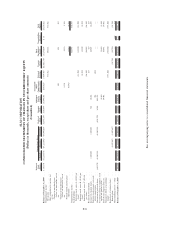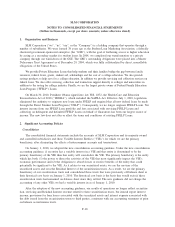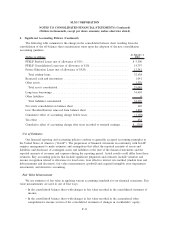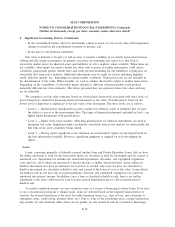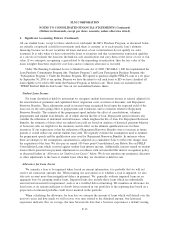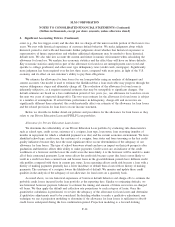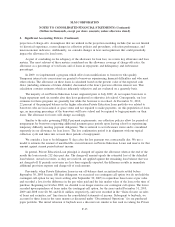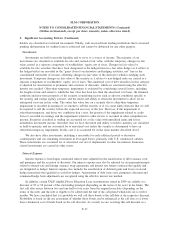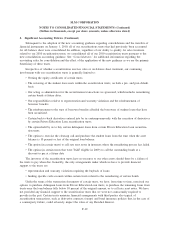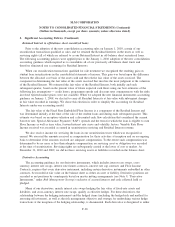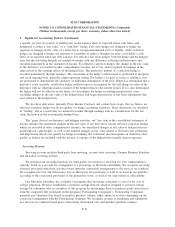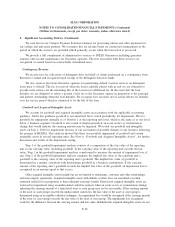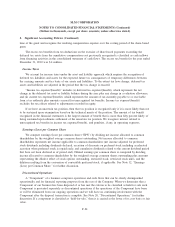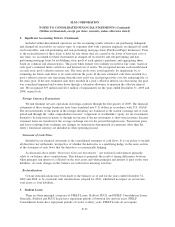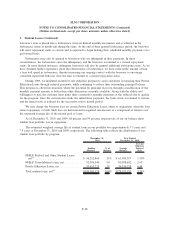Sallie Mae 2010 Annual Report Download - page 121
Download and view the complete annual report
Please find page 121 of the 2010 Sallie Mae annual report below. You can navigate through the pages in the report by either clicking on the pages listed below, or by using the keyword search tool below to find specific information within the annual report.2. Significant Accounting Policies (Continued)
reduction to interest expense through the first call date using the effective interest rate method. If it becomes less
than probable we will call these bonds at a future date, it will result in us reversing this prior accretion as a
cumulative catch up adjustment. We have accreted approximately $172 million as a reduction of interest expense
through December 31, 2010.
Transfer of Financial Assets and Extinguishments of Liabilities
We account for loan sales and debt repurchases in accordance with the applicable accounting guidance.
Our indentured trust debt, ABCP borrowings, ED Conduit and ED Participation Program facility were
accounted for as on-balance sheet secured borrowings. See “Securitization Accounting” below for further
discussion on the criteria assessed to determine whether a transfer of financial assets is a sale or a secured
borrowing. If a transfer of loans qualifies as a sale we derecognize the loan and recognize a gain or loss as the
difference between the carry basis of the loan sold and liabilities retained and the compensation received.
We periodically repurchase our outstanding debt in the open market or through public tender offers. We
record a gain or loss on the early extinguishment of debt based upon the difference between the carrying cost
of the debt and the amount paid to the third party and is net of hedging gains and losses, where the debt is in
a qualifying hedge relationship.
We recognize the results of a transfer of loans and the extinguishment of debt based upon the settlement
date of the transaction.
Securitization Accounting
Our securitizations use a two-step structure with a special purpose entity that legally isolates the
transferred assets from us, even in the event of bankruptcy. Transactions receiving sale treatment are also
structured to ensure that the holders of the beneficial interests issued are not constrained from pledging or
exchanging their interests, and that we do not maintain effective control over the transferred assets. If these
criteria are not met, then the transaction is accounted for as an on-balance sheet secured borrowing. In all
cases, irrespective of whether they qualify as accounting sales our securitizations are structured such that
legally they are sales of assets that isolate the transferred assets from us.
We assess the financial structure of each securitization to determine whether the trust or other
securitization vehicle meets the sale criteria and account for the transaction accordingly. Prior to January 1,
2010 (when the new accounting guidance for transfers of financial instruments was implemented which
eliminated the concept of a QSPE) certain trusts would qualify as a QSPE and be accounted for as off-balance
sheet trusts if they met all of the applicable criteria.
Prior to the adoption on January 1, 2010 of the new accounting guidance that eliminated the concept of
QSPEs, in certain securitizations there were terms present within the deal structure that resulted in such
securitizations not qualifying for sale treatment by failing to meet the criteria required for the securitization
entity (trust) to be a QSPE. Accordingly, these securitization trusts were accounted for as VIEs. Because we
were considered the primary beneficiary in such VIEs, the transfer is deemed a financing and the trust was
consolidated in our financial statements. The terms present in these structures that prevent sale treatment were:
(1) we hold rights that can affect the remarketing of specific trust bonds that are not significantly limited in
nature, (2) the trust has the right to enter into interest rate cap agreements after its settlement date that do not
relate to the reissuance of third-party beneficial interests or (3) we hold an unconditional call option related to
a certain percentage of trust assets.
F-18
SLM CORPORATION
NOTES TO CONSOLIDATED FINANCIAL STATEMENTS (Continued)
(Dollars in thousands, except per share amounts, unless otherwise stated)


